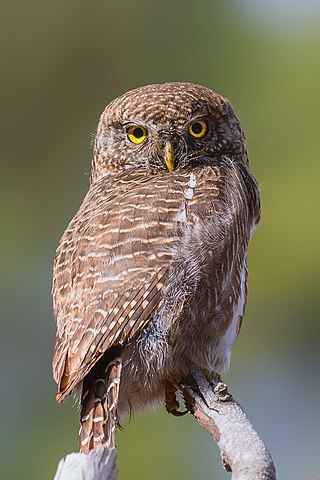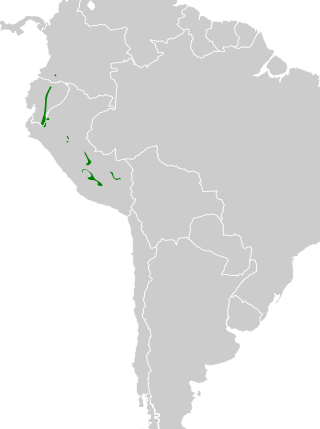
Owls are birds from the order Strigiformes, which includes over 200 species of mostly solitary and nocturnal birds of prey typified by an upright stance, a large, broad head, binocular vision, binaural hearing, sharp talons, and feathers adapted for silent flight. Exceptions include the diurnal northern hawk-owl and the gregarious burrowing owl.

The true owls or typical owls are one of the two generally accepted families of owls, the other being the barn owls (Tytonidae). This large family comprises 230 living or recently extinct species in 24 genera. The typical owls have a cosmopolitan distribution and are found on every continent except Antarctica.

The flammulated owl is a small migratory North American owl in the family Strigidae. It is the only species placed in the genus Psiloscops.

The elf owl is a small grayish-brown owl about the size of a sparrow found in the Southwestern United States, central Mexico, and the Baja California peninsula. It has pale yellow eyes highlighted by thin white "eyebrows" and a gray bill with a horn-colored tip. The elf owl frequently inhabits woodpecker holes in saguaro cacti; it also nests in natural tree cavities. It is nocturnal and feeds primarily on insects.

Pygmy owls are members of the genus Glaucidium. They belong to the typical owl family, Strigidae. The genus consists of 29 species distributed worldwide. These are mostly small owls, and some of the species are called "owlets". The genus includes nocturnal, diurnal, and crepuscular species. Birds in this genus mainly hunt large insects and other small prey.

The Puerto Rican owl or múcaro común, formerly known as the Puerto Rican screech owl, is a mid-sized "typical owl" in subfamily Striginae. It is endemic to the archipelago of Puerto Rico though it formerly also inhabited the Virgin Islands.

The striped owl is a medium-sized owl with large ear tufts and a brownish-white facial disk rimmed with black. Its beak is black, and it has cinnamon-colored eyes. It has shorter, rounder wings than most of its close relatives. The upperparts are cinnamon with fine black vermiculation and heavy stripes. The underparts are pale tawny with dusky streaks. It is native to South America and parts of Central America.

The Jamaican owl is a medium-sized owl that is endemic to the island of Jamaica.

The Asian Barred Owlet also known as the Cuckoo owlet is a species of pygmy owl native to the forests and shrublands of mainland Southeast Asia to the foothills of the Himalayas of northern Pakistan. It is a smaller owl, measuring 22–25 cm (8.7–9.8 in) making it one of the larger pygmy owls. They are primarily insectivorous but will eat lizards, small rodents and birds as well.

The cloud-forest pygmy owl is a short, muscular, small-sized species of owl found throughout the Andes of western Colombia and north-western Ecuador, being confined to cloud forests between 900–2000 m a.s.l. Below this altitudinal range the Central American pygmy owl occurs; above it, the Andean pygmy owl occurs.

The Colima pygmy owl is a species of owl in the family Strigidae. It is endemic to the western part of Mexico.

The subtropical pygmy owl is a species of owl in the family Strigidae. It is found in Bolivia, Colombia, Ecuador, and Peru.

The Tamaulipas pygmy owl is a species of owl in the family Strigidae. It is endemic to Mexico. This is one of the smallest owls in the world, with a mean length of 13.5 cm (5.3 in). However, at 53 g (1.9 oz), it is slightly heavier than the long-whiskered owlet and the elf owl. Its natural habitat is subtropical or tropical moist montane forests.

Ketupa is a genus of owls in the family Strigidae. The genus formerly contained just three species, the fish owls but based on the results from a genetic study published in 2020, the generic boundaries were altered. The genus now contains twelve species, nine of which were formerly placed in the genus Bubo.
The Palau scops owl or Palau owl is a species of owl in the family Strigidae. Palau scops owls are dark reddish-brown with small white dots scattered across their feathers. They are endemic to the Palau Islands in the western Pacific, where they are found in woodland and lagoon trees, ravines and mangrove swamps. Palau owls nest in hollows of trees, live in groups and are territorial.

The Pernambuco pygmy owl is a species of owl in the family Strigidae. This species, first described in 2002, is endemic to Pernambuco state in Brazil.
George Hines Lowery Jr. was an American ornithologist and professor of zoology at Louisiana State University, who pioneered a technique for studying nocturnal bird migration by large-scale observation through telescopes across the United States of America of flocks of birds as they flew at night in front of the face of the moon.

The jalca tapaculo is a species of bird in the family Rhinocryptidae. It is endemic to Peru.

Taenioptynx is a genus of typical owls, or true owls, in the family Strigidae, that inhabits Asia.

Surniinae is a subfamily of the typical owls (Strigidae). First described by French ornithologist Charles Lucien Bonaparte in 1838. The type genus is Surnia. Includes ten genera.





















